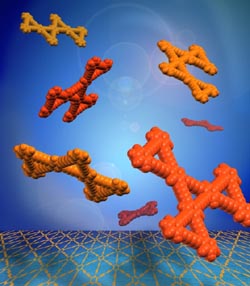Home > Press > Carbon-rich molecules "supersized" for the first time
Abstract:
The giant superstructures permit researchers to test predictions of usefulness for synthetic carbon
Carbon-rich molecules "supersized" for the first time
Eugene, OR | Posted on December 02, 2005
A University of Oregon chemist has "supersized"
carbon-rich molecules, enabling researchers for the first time to test
theories about the useful properties of synthetic forms of carbon. The
discovery by Mike Haley will be published as the cover story in the Dec.
9 edition of the Journal of Organic Chemistry (JOC). The story will be
posted on the JOC website today (Dec. 2).

Artist's conception of chemistry professor Mike Haley's "supersized" carbon-rich molecules. Image credit: Annie Tykwinski.
|
Scientists have long predicted that unnatural forms of carbon could have
many technologically useful properties, much like those found for the
natural phases of carbon, which are graphite and diamond. Haley's
research seeks to prove those predictions are true and to do so, the new
carbon materials must be of sufficient size to observe their properties.
"'Supersizing' fragments of unnatural carbon has enormous implications
for determining future applications because certain properties can only
be realized at much larger dimensions," said Haley. At a diameter of
five to six nanometers (a nanometer is a billionth of a meter) the new
disk-shaped molecules are more than twice the size of the one-to-two
nanometer pieces previously developed by Haley's team. For instance,
Haley explains that molecules of polystyrene used for Styrofoam cups are
rigid because of their large size. At much smaller molecule sizes,
however, the same material is a viscous liquid. "Size is important," he
said.
Haley and doctoral student Jeremiah Marsden were able to produce several
different supersized molecules by using acetylene subunits to link
benzene anchors to form the giant networks. The expanded molecules have
a high density of pi-electrons that are extremely useful for electronics
and optics. Haley said the most promising application for the new
material is in optical electronics and, specifically, switches used in
telecommunications. Haley's group is collaborating with researchers at
the University of Michigan to test the strength, reliability, and
durability of the new material.
Mike Haley is a professor of chemistry and a member of the university's
Materials Science Institute. His research was funded by a grant from the
National Science Foundation.
Mike Haley
541-346-0456
Haley@uoregon.edu
Contact:
Kathy Madison
541-346-3145
kmadison@uoregon.edu
Links:
Mike Haley Webpage
The Journal of Organic Chemistry
Carbon Networks Based on Dehydrobenzoannulenes
Copyright © University of Oregon
If you have a comment, please Contact us.
Issuers of news releases, not 7th Wave, Inc. or Nanotechnology Now, are solely responsible for the accuracy of the content.
| Related News Press |
Possible Futures
![]() Spinel-type sulfide semiconductors to operate the next-generation LEDs and solar cells For solar-cell absorbers and green-LED source October 3rd, 2025
Spinel-type sulfide semiconductors to operate the next-generation LEDs and solar cells For solar-cell absorbers and green-LED source October 3rd, 2025
Materials/Metamaterials/Magnetoresistance
![]() First real-time observation of two-dimensional melting process: Researchers at Mainz University unveil new insights into magnetic vortex structures August 8th, 2025
First real-time observation of two-dimensional melting process: Researchers at Mainz University unveil new insights into magnetic vortex structures August 8th, 2025
![]() Researchers unveil a groundbreaking clay-based solution to capture carbon dioxide and combat climate change June 6th, 2025
Researchers unveil a groundbreaking clay-based solution to capture carbon dioxide and combat climate change June 6th, 2025
![]() A 1960s idea inspires NBI researchers to study hitherto inaccessible quantum states June 6th, 2025
A 1960s idea inspires NBI researchers to study hitherto inaccessible quantum states June 6th, 2025
![]() Institute for Nanoscience hosts annual proposal planning meeting May 16th, 2025
Institute for Nanoscience hosts annual proposal planning meeting May 16th, 2025
Announcements
![]() Rice membrane extracts lithium from brines with greater speed, less waste October 3rd, 2025
Rice membrane extracts lithium from brines with greater speed, less waste October 3rd, 2025
![]() Researchers develop molecular qubits that communicate at telecom frequencies October 3rd, 2025
Researchers develop molecular qubits that communicate at telecom frequencies October 3rd, 2025
![]() Next-generation quantum communication October 3rd, 2025
Next-generation quantum communication October 3rd, 2025
![]() "Nanoreactor" cage uses visible light for catalytic and ultra-selective cross-cycloadditions October 3rd, 2025
"Nanoreactor" cage uses visible light for catalytic and ultra-selective cross-cycloadditions October 3rd, 2025
|
|
||
|
|
||
| The latest news from around the world, FREE | ||
|
|
||
|
|
||
| Premium Products | ||
|
|
||
|
Only the news you want to read!
Learn More |
||
|
|
||
|
Full-service, expert consulting
Learn More |
||
|
|
||








